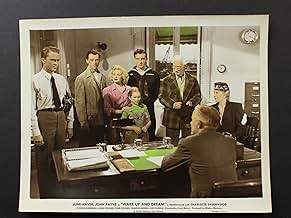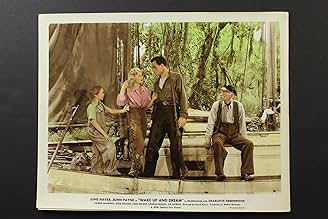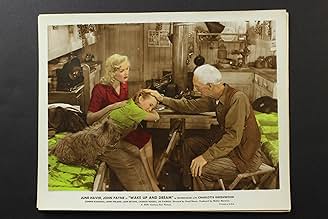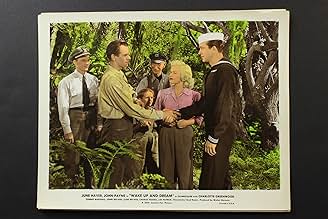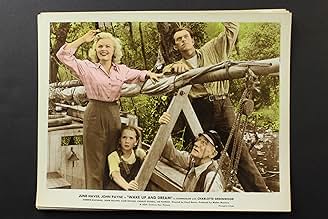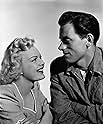Aggiungi una trama nella tua linguaA little girl asks her guardians to take her by boat to a nearby swamp believing her older brother, a sailor who recently went M.I.A. in WWII, is somehow there. She finds a grumpy old Crusoe... Leggi tuttoA little girl asks her guardians to take her by boat to a nearby swamp believing her older brother, a sailor who recently went M.I.A. in WWII, is somehow there. She finds a grumpy old Crusoe-like hermit, instead, but there's still hope.A little girl asks her guardians to take her by boat to a nearby swamp believing her older brother, a sailor who recently went M.I.A. in WWII, is somehow there. She finds a grumpy old Crusoe-like hermit, instead, but there's still hope.
Eddie Acuff
- Bus Driver
- (non citato nei titoli originali)
Ernest Anderson
- Black Man
- (non citato nei titoli originali)
Stanley Andrews
- Conductor
- (non citato nei titoli originali)
Oliver Blake
- Mr. Agrippa
- (non citato nei titoli originali)
Harlan Briggs
- Praddle
- (non citato nei titoli originali)
George Cleveland
- Prof. Feverfew
- (non citato nei titoli originali)
Marvin Davis
- Lester Lucash
- (non citato nei titoli originali)
Francis Ford
- Old Man at Counter
- (non citato nei titoli originali)
Recensioni in evidenza
Starts out with a sappy WW II romance between waitress June Haver and farmer John Payne. He's too shy and she's impatient. He's got a mopey kid sister (Connie Marshall) and then there's the town crank (Clem Bevans) who's been building a boat even though they are nowhere near water. Payne enlists and goes off to war.
When they get a letter saying Payne's missing in action, they (accidentally) set off on a boat journey to find him. Here's where the film tries to link to THE WIZARD OF OZ by playing the theme song over and over again. On the road, the trio runs into a failed dentist (John Ireland) who joins the quest. He becomes useful, especially when they finally find a river.
They get lost on the waterways and come upon a nutty recluse (the wizard?) but a navy plane spots the stranded boat and they are rescued ... just about the time Payne returns unharmed.
Nothing about the plot makes any sense at all. The main story about the boat is annoying because it's so stupid, and the analogies to the Oz story makes no sense either.
Haver comes off best but that's no great prize. Payne is hardly in the film. Ireland is good but his character is strange. Bevans is way too hammy, and Marshall seems to be channeling Margaret O'Brien as a weepy and nearly hysterical child. George Cleveland plays the recluse. Charlotte Greenwood is totally wasted as the landlady (she may be the wife) of the Bevans character. Other familiar faces include Charles D. Brown as the commander, Minerva Urecal as the gossip, Charles Russell as Coles, and Lee Patrick who seems to be the woman sitting on a stool.
The song "Give Me the Simple Life" is the only good thing to come out of this mess.
When they get a letter saying Payne's missing in action, they (accidentally) set off on a boat journey to find him. Here's where the film tries to link to THE WIZARD OF OZ by playing the theme song over and over again. On the road, the trio runs into a failed dentist (John Ireland) who joins the quest. He becomes useful, especially when they finally find a river.
They get lost on the waterways and come upon a nutty recluse (the wizard?) but a navy plane spots the stranded boat and they are rescued ... just about the time Payne returns unharmed.
Nothing about the plot makes any sense at all. The main story about the boat is annoying because it's so stupid, and the analogies to the Oz story makes no sense either.
Haver comes off best but that's no great prize. Payne is hardly in the film. Ireland is good but his character is strange. Bevans is way too hammy, and Marshall seems to be channeling Margaret O'Brien as a weepy and nearly hysterical child. George Cleveland plays the recluse. Charlotte Greenwood is totally wasted as the landlady (she may be the wife) of the Bevans character. Other familiar faces include Charles D. Brown as the commander, Minerva Urecal as the gossip, Charles Russell as Coles, and Lee Patrick who seems to be the woman sitting on a stool.
The song "Give Me the Simple Life" is the only good thing to come out of this mess.
Although some may argue that the best part of this film is the frequently used song "Give Me the Simple Life," I found it to be relaxing and charming.
When viewing any film like this, I believe it's important to remember that it was released after our nation had endured a decade of depression followed by 4 years of the horror of WWII. This quiet little film provided relief from the stress of those traumatic years, and a glimmer of hope for the future.
The entire cast was down home friendly and comfortable to watch. The color photography is warm and welcoming, and the background score provides the appropriate mood for each scene and some hope for the future.
I watched it on Classic Reel one chilly Spring morning and enjoyed every minute.
When viewing any film like this, I believe it's important to remember that it was released after our nation had endured a decade of depression followed by 4 years of the horror of WWII. This quiet little film provided relief from the stress of those traumatic years, and a glimmer of hope for the future.
The entire cast was down home friendly and comfortable to watch. The color photography is warm and welcoming, and the background score provides the appropriate mood for each scene and some hope for the future.
I watched it on Classic Reel one chilly Spring morning and enjoyed every minute.
This charming picture, if most previous reviewers consider it quite poorly, has many qualities that make it special. Based on the poster and DVD cover you might expect a musical, even more when it opens with John Payne singing "Give me the simple life" (and doing it so well), when it is only partially so. There are a couple of songs performed by him and June Haver as Jenny (also so nicely sung), but that´s all. Instead, this story turns to be better than that, shifting to the questions of maintaining personal beliefs and hopes in hard times (a war going on), helping one another and true friendship. Because when Payne joins the Navy and we see no more of him for most of the film, it is his little sister Nella (Connie Marshall), Jenny and their neighbour optimistic ship builder Henry Pecket (wonderful Clem Bevans, by whose acting alone this movie deserves to be watched) that will find in their mutual friendship an unexpected way to face the hardships of life and try to find a way ahead through a shared dream (navigating Pecket´s backyard-built ship) that brings them both comfort and adventure. And this is what the story is about, above all. They are joined by a discharged soldier, a young John Ireland in a role so distant from his excellent villains.
The soft pastel-toned color is another good achievement, enhancing June Haver´s beauty. By the way, you might also like The Little Ark from 1972.
So by everyone interested in the best of human nature this story will be enjoyed. It´s one of those movies they hardly ever do nowadays and are both entertaining and interesting. In fact, you can guess its tone from the starting frames with "Once upon a time...", and as the song says, "... sounds corny and seedy, but yes, indeede, give me the simple life". And that´s what is all about.
The soft pastel-toned color is another good achievement, enhancing June Haver´s beauty. By the way, you might also like The Little Ark from 1972.
So by everyone interested in the best of human nature this story will be enjoyed. It´s one of those movies they hardly ever do nowadays and are both entertaining and interesting. In fact, you can guess its tone from the starting frames with "Once upon a time...", and as the song says, "... sounds corny and seedy, but yes, indeede, give me the simple life". And that´s what is all about.
Far and away, that's the most memorable song in this naïve and dated war-time fantasy, based on the novel "The Enchanted Voyage" by Robert Nathan, directed by Lloyd Bacon.
Since I'm a fan of 20th-Century Fox musicals of the Golden Age, I anticipated a great deal of lively, tuneful fun from "Wake Up and Dream", and I was disappointed by what I saw. A naïve, substandard children's fantasy, it mainly works as heavily sentimental reflection of its war-enshrouded time.
John Payne plays a farmer Jeff Cairn who, after he enlists in the Navy, disappears and is believed to be dead. Connie Marshall is his young sister Nella who is searching for him, along with a good-hearted old coot (Clem Bevans) in a boat called "Sara March".
June Haver, who deserved better than what she got, plays the saccharine waitress Jenny falling in love with Payne and goes along with the voyage, together with an eccentric dentist played by John Ireland.
The highlights are Payne's heartwarming rendition of "Give Me the Simple Life" at the beginning, and then later Haver, in a moment of sweet vulnerability, sings the song to show her love and adoration for Payne.
The Technicolor looks sumptuous, but the story is not that interesting. I suggest you skip it, unless you're interested in the stars or the subject.
Since I'm a fan of 20th-Century Fox musicals of the Golden Age, I anticipated a great deal of lively, tuneful fun from "Wake Up and Dream", and I was disappointed by what I saw. A naïve, substandard children's fantasy, it mainly works as heavily sentimental reflection of its war-enshrouded time.
John Payne plays a farmer Jeff Cairn who, after he enlists in the Navy, disappears and is believed to be dead. Connie Marshall is his young sister Nella who is searching for him, along with a good-hearted old coot (Clem Bevans) in a boat called "Sara March".
June Haver, who deserved better than what she got, plays the saccharine waitress Jenny falling in love with Payne and goes along with the voyage, together with an eccentric dentist played by John Ireland.
The highlights are Payne's heartwarming rendition of "Give Me the Simple Life" at the beginning, and then later Haver, in a moment of sweet vulnerability, sings the song to show her love and adoration for Payne.
The Technicolor looks sumptuous, but the story is not that interesting. I suggest you skip it, unless you're interested in the stars or the subject.
In case anyone is asking Wake Up And Dream is not a musical version of the Thirties Cole Porter review, nor is it a remake of the Universal film from the Thirties of the same title. This film is a whole other creature altogether and mainly known for introducing the song Give Me The Simple Life.
In fact the film starts out with John Payne singing Give Me The Simple Life to his little sister Connie Marshall. Payne's decided to enlist in the Navy and he does and then strangely disappears for most of the film until the end.
That's because he's reported missing in action and little Connie decides to use the good services of Clem Bevans who's built a sailing craft in his landlocked town and wants to offer to the U.S. Navy in time of war. And also to get away occasionally from his wife Charlotte Greenwood. Bevans and Marshall together with June Haver a server at the local diner all start out humoring the child's fantasy about finding her missing brother. Along the way they pick up a discharged seaman in John Ireland who joins their merry crew.
Wake Up And Dream is a strange film that quite frankly I didn't get most of the time. This one was strictly for the kid trade back in 1946.
Still it did introduce a very popular song, sung first by Payne and then by June Haver on the screen. But Darryl F. Zanuck frowned on his stars making records and the hit record in 1946 was done by Bing Crosby. The song perfectly fits his style. Back in the day Bing must have insisted to Jack Kapp at Decca records that he record Give Me The Simple Life which was written by Harry Ruby and Rube Bloom.
If you like the song and the stars than you should see Wake Up And Dream, otherwise you can sleep through it and not miss all that much.
In fact the film starts out with John Payne singing Give Me The Simple Life to his little sister Connie Marshall. Payne's decided to enlist in the Navy and he does and then strangely disappears for most of the film until the end.
That's because he's reported missing in action and little Connie decides to use the good services of Clem Bevans who's built a sailing craft in his landlocked town and wants to offer to the U.S. Navy in time of war. And also to get away occasionally from his wife Charlotte Greenwood. Bevans and Marshall together with June Haver a server at the local diner all start out humoring the child's fantasy about finding her missing brother. Along the way they pick up a discharged seaman in John Ireland who joins their merry crew.
Wake Up And Dream is a strange film that quite frankly I didn't get most of the time. This one was strictly for the kid trade back in 1946.
Still it did introduce a very popular song, sung first by Payne and then by June Haver on the screen. But Darryl F. Zanuck frowned on his stars making records and the hit record in 1946 was done by Bing Crosby. The song perfectly fits his style. Back in the day Bing must have insisted to Jack Kapp at Decca records that he record Give Me The Simple Life which was written by Harry Ruby and Rube Bloom.
If you like the song and the stars than you should see Wake Up And Dream, otherwise you can sleep through it and not miss all that much.
Lo sapevi?
- QuizThe jukebox in the cafe when June Haver dances with and sings "I Wish I Could Tell You" to John Payne is a Wurlitzer 412, circa 1936, of which more than 30,000 were produced. The machine held only a dozen 78-rpm records and could only play one side. During WW2, production of jukeboxes was halted as materials were needed for the war effort, and since this film is set in 1943, it stands to reason that a small cafe would still be making good use of its 1936 jukebox. After WW2, jukeboxes went back into full production, and thousands upon thousands were placed in cafes, diners, bars and restaurants nationwide.
- ConnessioniReferences Il mago di Oz (1939)
I più visti
Accedi per valutare e creare un elenco di titoli salvati per ottenere consigli personalizzati
Dettagli
- Tempo di esecuzione1 ora 32 minuti
- Proporzioni
- 1.37 : 1
Contribuisci a questa pagina
Suggerisci una modifica o aggiungi i contenuti mancanti

Divario superiore
By what name was Wake Up and Dream (1946) officially released in India in English?
Rispondi
